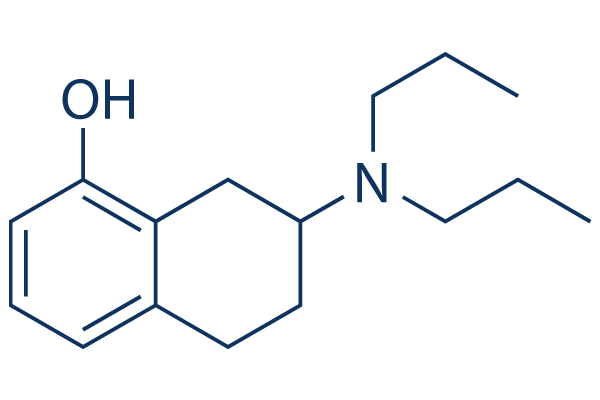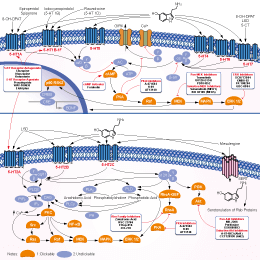
- Bioactive Compounds
- By Signaling Pathways
- PI3K/Akt/mTOR
- Epigenetics
- Methylation
- Immunology & Inflammation
- Protein Tyrosine Kinase
- Angiogenesis
- Apoptosis
- Autophagy
- ER stress & UPR
- JAK/STAT
- MAPK
- Cytoskeletal Signaling
- Cell Cycle
- TGF-beta/Smad
- DNA Damage/DNA Repair
- Compound Libraries
- Popular Compound Libraries
- Customize Library
- Clinical and FDA-approved Related
- Bioactive Compound Libraries
- Inhibitor Related
- Natural Product Related
- Metabolism Related
- Cell Death Related
- By Signaling Pathway
- By Disease
- Anti-infection and Antiviral Related
- Neuronal and Immunology Related
- Fragment and Covalent Related
- FDA-approved Drug Library
- FDA-approved & Passed Phase I Drug Library
- Preclinical/Clinical Compound Library
- Bioactive Compound Library-I
- Bioactive Compound Library-Ⅱ
- Kinase Inhibitor Library
- Express-Pick Library
- Natural Product Library
- Human Endogenous Metabolite Compound Library
- Alkaloid Compound LibraryNew
- Angiogenesis Related compound Library
- Anti-Aging Compound Library
- Anti-alzheimer Disease Compound Library
- Antibiotics compound Library
- Anti-cancer Compound Library
- Anti-cancer Compound Library-Ⅱ
- Anti-cancer Metabolism Compound Library
- Anti-Cardiovascular Disease Compound Library
- Anti-diabetic Compound Library
- Anti-infection Compound Library
- Antioxidant Compound Library
- Anti-parasitic Compound Library
- Antiviral Compound Library
- Apoptosis Compound Library
- Autophagy Compound Library
- Calcium Channel Blocker LibraryNew
- Cambridge Cancer Compound Library
- Carbohydrate Metabolism Compound LibraryNew
- Cell Cycle compound library
- CNS-Penetrant Compound Library
- Covalent Inhibitor Library
- Cytokine Inhibitor LibraryNew
- Cytoskeletal Signaling Pathway Compound Library
- DNA Damage/DNA Repair compound Library
- Drug-like Compound Library
- Endoplasmic Reticulum Stress Compound Library
- Epigenetics Compound Library
- Exosome Secretion Related Compound LibraryNew
- FDA-approved Anticancer Drug LibraryNew
- Ferroptosis Compound Library
- Flavonoid Compound Library
- Fragment Library
- Glutamine Metabolism Compound Library
- Glycolysis Compound Library
- GPCR Compound Library
- Gut Microbial Metabolite Library
- HIF-1 Signaling Pathway Compound Library
- Highly Selective Inhibitor Library
- Histone modification compound library
- HTS Library for Drug Discovery
- Human Hormone Related Compound LibraryNew
- Human Transcription Factor Compound LibraryNew
- Immunology/Inflammation Compound Library
- Inhibitor Library
- Ion Channel Ligand Library
- JAK/STAT compound library
- Lipid Metabolism Compound LibraryNew
- Macrocyclic Compound Library
- MAPK Inhibitor Library
- Medicine Food Homology Compound Library
- Metabolism Compound Library
- Methylation Compound Library
- Mouse Metabolite Compound LibraryNew
- Natural Organic Compound Library
- Neuronal Signaling Compound Library
- NF-κB Signaling Compound Library
- Nucleoside Analogue Library
- Obesity Compound Library
- Oxidative Stress Compound LibraryNew
- Plant Extract Library
- Phenotypic Screening Library
- PI3K/Akt Inhibitor Library
- Protease Inhibitor Library
- Protein-protein Interaction Inhibitor Library
- Pyroptosis Compound Library
- Small Molecule Immuno-Oncology Compound Library
- Mitochondria-Targeted Compound LibraryNew
- Stem Cell Differentiation Compound LibraryNew
- Stem Cell Signaling Compound Library
- Natural Phenol Compound LibraryNew
- Natural Terpenoid Compound LibraryNew
- TGF-beta/Smad compound library
- Traditional Chinese Medicine Library
- Tyrosine Kinase Inhibitor Library
- Ubiquitination Compound Library
-
Cherry Picking
You can personalize your library with chemicals from within Selleck's inventory. Build the right library for your research endeavors by choosing from compounds in all of our available libraries.
Please contact us at [email protected] to customize your library.
You could select:
- Antibodies
- Bioreagents
- qPCR
- 2x SYBR Green qPCR Master Mix
- 2x SYBR Green qPCR Master Mix(Low ROX)
- 2x SYBR Green qPCR Master Mix(High ROX)
- Protein Assay
- Protein A/G Magnetic Beads for IP
- Anti-Flag magnetic beads
- Anti-Flag Affinity Gel
- Anti-Myc magnetic beads
- Anti-HA magnetic beads
- Magnetic Separator
- Poly DYKDDDDK Tag Peptide lyophilized powder
- Protease Inhibitor Cocktail
- Protease Inhibitor Cocktail (EDTA-Free, 100X in DMSO)
- Phosphatase Inhibitor Cocktail (2 Tubes, 100X)
- Cell Biology
- Cell Counting Kit-8 (CCK-8)
- Animal Experiment
- Mouse Direct PCR Kit (For Genotyping)
- New Products
- Contact Us
8-OH-DPAT (8-Hydroxy-DPAT)
8-OH-DPAT (8-Hydroxy-DPAT) is a kind of classic 5-HT1A agonist with the pIC50 of 8.19. It has a selectivity of almost-1000 fold for a subtype of the 5-HT1 binding site; Its biological half-life is 1.5 hous.

8-OH-DPAT (8-Hydroxy-DPAT) Chemical Structure
CAS No. 78950-78-4
Purity & Quality Control
Batch:
Purity:
99.03%
99.03
8-OH-DPAT (8-Hydroxy-DPAT) Related Products
| Related Targets | 5-HT1 5-HT2 5-HT3 5-HT4 5-HT6 5-HT7 5-HT5 | Click to Expand |
|---|---|---|
| Related Products | Puerarin WAY-100635 Maleate Serotonin (5-HT) HCl BRL-15572 Dihydrochloride SB269970 HCl Ketanserin RS-127445 Azacyclonol Nuciferine Flopropione SB742457 BRL 15572 BRL-54443 Perospirone hydrochloride Alverine Citrate Ramosetron Hydrochloride SB 271046 hydrochloride PRX-08066 Maleic acid Blonanserin | Click to Expand |
| Related Compound Libraries | FDA-approved Drug Library Natural Product Library Neuronal Signaling Compound Library CNS-Penetrant Compound Library Anti-alzheimer Disease Compound Library | Click to Expand |
Signaling Pathway
Biological Activity
| Description | 8-OH-DPAT (8-Hydroxy-DPAT) is a kind of classic 5-HT1A agonist with the pIC50 of 8.19. It has a selectivity of almost-1000 fold for a subtype of the 5-HT1 binding site; Its biological half-life is 1.5 hous. | ||
|---|---|---|---|
| Targets |
|
| In vitro | ||||
| In vitro | The drug is only weakly effective at 5-HT1B subtype, the pIC50 being 5.42 ± 0.08 (n = 5). Since 8-OH-DPAT has no effect on 5-HT1B binding at concentrations lower than 100 nM[1]. 8-OH-DPAT is able to reduce the accumulation of both autophagic-derived and photoreceptor outer segment-derived lipofuscin, increase antioxidant protection and reduce oxidative damage in cultured human RPE cells[4]. | |||
|---|---|---|---|---|
| Cell Research | Cell lines | Retinal pigment epithelial (RPE) cells | ||
| Concentrations | 10 μM | |||
| Incubation Time | 24 h | |||
| Method | Cells are exposed to H2O2 (200 µM) for 1 hour and either pre-or post treated with 8-OH DPAT (10 µM) for 24 hours. In the case of pretreatment all measurements are made 24 hr after H2O2 and for post treatment 8-OH DPAT is added immediately following H2O2 exposure. 5HT1A agonist treatment: To assess the ability of the 5-HT1A receptor agonist, 8-OH DPAT, to reduce lipofuscin formation in cultured RPE cells, this compound is added to the culture medium every 48 hours at concentrations ranging from 0.1 to 20 µM. All experiments are undertaken in basal medium, and cells receiving vehicle alone (PBS) acted as negative controls. To determine if the effect of 8-OH DPAT is sustained following discontinuation of 5-HT1A receptor agonist treatment, 8-OH DPAT treatment is discontinued after 28 days and the cells maintained in basal medium or fed POS for a further 28 days. To assess the ability of 8-OH DPAT to remove existing lipofuscin, autophagy-derived lipofuscin and phagocytic-derived lipofuscin are allowed to accumulate as described above and then 8-OH DPAT is added every second day for up to 28 days. To confirm that 8-OH DPAT is acting via the 5-HT1A receptor agonist we include the 5-HT1A receptor antagonist S(-)-UH-301 at 5 µM in some experiments. To determine the effect of timing of 8-OH DPAT treatment on oxidative stress markers, RPE cultures are either pre-treated with 8-OH DPAT (at 1 or 10 µM) for 3 or 24 hours prior to exposure to 200 µM H2O2 for 1 hour or treated with the 5HT1A agonist for 3 or 24 hours post-exposure to H2O2. Cells not exposed to oxidative stressor serve as a negative control, and cells exposed to oxidative stressor but not 8-OH DPAT serve as a positive control. Cells exposed to 8-OH DPAT only act as an additional control. |
|||
| In Vivo | ||
| In vivo | Intravenous administration of the selective 5-HT1A-receptor agonist 8-OH-DPAT rapidly reverses the hypotensive and bradycardic responses established during severe hemorrhage with relatively little variability. 8-OH-DPAT is relatively lipophilic and readily crosses the blood-brain barrier[3]. | |
|---|---|---|
| Animal Research | Animal Models | Male Lister hooded rats |
| Dosages | 0, 3.0, 10, 100 and 300 μg/kg | |
| Administration | i.p. | |
Chemical Information & Solubility
| Molecular Weight | 247.38 | Formula | C16H25NO |
| CAS No. | 78950-78-4 | SDF | Download 8-OH-DPAT (8-Hydroxy-DPAT) SDF |
| Smiles | CCCN(CCC)C1CCC2=C(C1)C(=CC=C2)O | ||
| Storage (From the date of receipt) | |||
|
In vitro |
DMSO : 49 mg/mL ( (198.07 mM) Moisture-absorbing DMSO reduces solubility. Please use fresh DMSO.) Ethanol : 49 mg/mL Water : Insoluble |
Molecular Weight Calculator |
|
In vivo Add solvents to the product individually and in order. |
In vivo Formulation Calculator |
||||
Preparing Stock Solutions
Molarity Calculator
In vivo Formulation Calculator (Clear solution)
Step 1: Enter information below (Recommended: An additional animal making an allowance for loss during the experiment)
mg/kg
g
μL
Step 2: Enter the in vivo formulation (This is only the calculator, not formulation. Please contact us first if there is no in vivo formulation at the solubility Section.)
% DMSO
%
% Tween 80
% ddH2O
%DMSO
%
Calculation results:
Working concentration: mg/ml;
Method for preparing DMSO master liquid: mg drug pre-dissolved in μL DMSO ( Master liquid concentration mg/mL, Please contact us first if the concentration exceeds the DMSO solubility of the batch of drug. )
Method for preparing in vivo formulation: Take μL DMSO master liquid, next addμL PEG300, mix and clarify, next addμL Tween 80, mix and clarify, next add μL ddH2O, mix and clarify.
Method for preparing in vivo formulation: Take μL DMSO master liquid, next add μL Corn oil, mix and clarify.
Note: 1. Please make sure the liquid is clear before adding the next solvent.
2. Be sure to add the solvent(s) in order. You must ensure that the solution obtained, in the previous addition, is a clear solution before proceeding to add the next solvent. Physical methods such
as vortex, ultrasound or hot water bath can be used to aid dissolving.
Tech Support
Answers to questions you may have can be found in the inhibitor handling instructions. Topics include how to prepare stock solutions, how to store inhibitors, and issues that need special attention for cell-based assays and animal experiments.
Tel: +1-832-582-8158 Ext:3
If you have any other enquiries, please leave a message.
* Indicates a Required Field
Tags: buy 8-OH-DPAT (8-Hydroxy-DPAT) | 8-OH-DPAT (8-Hydroxy-DPAT) supplier | purchase 8-OH-DPAT (8-Hydroxy-DPAT) | 8-OH-DPAT (8-Hydroxy-DPAT) cost | 8-OH-DPAT (8-Hydroxy-DPAT) manufacturer | order 8-OH-DPAT (8-Hydroxy-DPAT) | 8-OH-DPAT (8-Hydroxy-DPAT) distributor







































